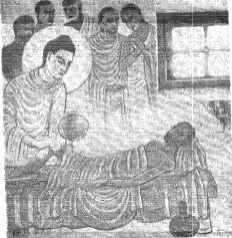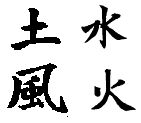The background to Buddhist medicine
The first medical practices amongst Buddhist temples and monks would have had a very practical orientation. Obviously as the earliest Monks were constantly wandering around teaching they had no regular access to hospitals or medical suppliers as such things did not exist at that time. It therefore fell to the monastic community itself to provide some means of looking after those who fell ill. Shakyamuni Buddha himself had directed monks to care for one another and to provide care for the sick and dying by furnishing them with medicines and other healing requirements.

However the adoption of a medical system by the monks did not occur in a void.
One common healing system of that time was based upon a sacred text known as the �life prolonging� (Ayur Veda)
Ayurvedic medicine was perhaps the last remnant of an earlier system which, through archaeological evidence, we know to have been very sophisticated and wide ranging. in its scope.
We also know that the ancient Indians possessed knowledge of a wide range of medicinal and therapeutic herbs from which they produced powerful drugs including anaesthetics such as Opium.
From the various medical implements that have been excavated we know that this early culture performed intricate surgical operations such as trepanation and was capable of performing various types of cosmetic surgery which included rebuilding the nose, fingers and other parts of the body.
Both the Ayurvedic system and the later Buddhist developments of it utilised a system of diagnosis and treatment which involved the elements of Fire, Water, Earth and Air.

Whereas the Ayurveda added a fifth element termed �Prana� (literally �the out breath�) The Buddhist system used another which was understood as either �space�, �energy� or �atmosphere� (Akasa) depending upon how it was to be utilised. The adoption of this interpretation of the fifth element had significant philosophical, cosmological and physiological interpretations
In Ayurveda there were considered to be three types of symptoms or activities rather like the Aristotelian �Humours� whereas in the Buddhist system there were five forms of symptoms, each being aligned to a specific element and type of treatment.
Unlike the Ayurvedic methods which remained largely within the culture and land of India the Buddhist systems were carried by missionaries of the religion into many other foreign lands, particularly China. Here it adapted itself to the local herbs and healing substances , including what it found useful into its ever expanding pharmocopaeia.
Chinese native healers and Shaman were also greatly influenced by the new Indian Buddhist methods and remedies and adopted many into their own repertoire. A great deal of what is now regarded as being traditional to China, be it herbal remedies or therapeutic techniques, came in fact first from the Indian system.
One great advantage the Buddhist healers had over their Chinese counterparts lay in their knowledge of and expertise in the art of Surgery and other physical remedial techniques. Surgery had been long forbidden in China due to its upholding Confucian ethics and consequently knowledge of the inner functions and workings of the human body had been very limited.

After the Muslim invasions of India around the first millenium Buddhism along with its medical systems all but disappeared from India and it was the lands to which Buddhism had spread which preserved much of its tradition, teachings & methods.
As it became established Buddhism and its associated cultural arts & teachings formed a powerful social force in the lands to which it spread and was responsible for the building of hospitals, for both people and animals, as well as providing local health services for the native populations.